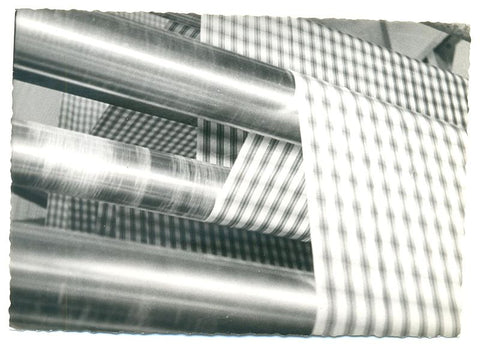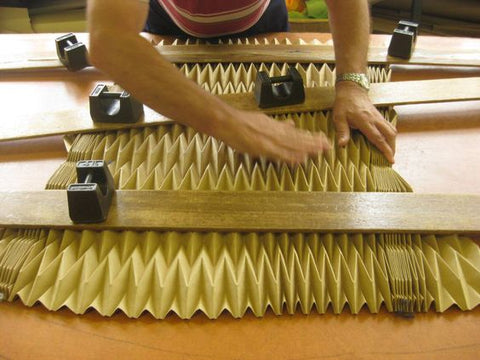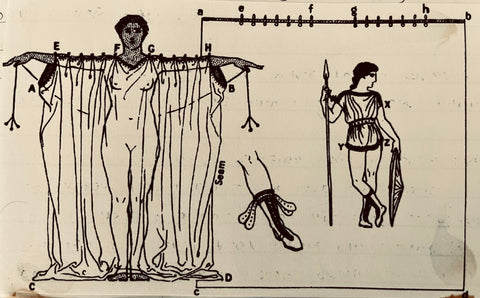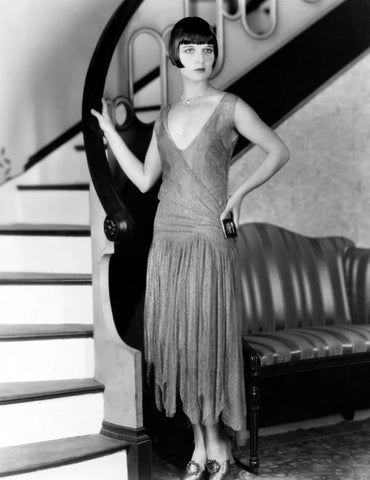The History of Clothing - a History of the Plissé
What is plissé, and what does it actually mean? When was it invented, and how did it develop? Why do people wear pleated skirts, and how did they get their name? How long has the technique been around, and is it still relevant today?
The subject of plissé and its preparation technique fascinates people worldwide. Who came up with the idea? How is it made? All this and more in this article.
The process of making a cloth fan using the plisse technique, Duvelleroy, France
What is Plissé?
The word "Plissé" means "pleats" in French. Originally, the term referred to fabric that was woven or gathered into pleats. Today, it describes lightweight fabric with a crinkled, striped surface. The term "plissé" can also refer to a chemical finishing technique (for example, plissé fabrics used in underwear).
The plissé technique is based on the concept of placing fabric between two folded cardboard molds and applying hot steam to the fabric until the pleated pattern from the cardboard is permanently set.

Before we delve deeper into the technique itself and what really happens during the process, let's first discuss fabric processing and finishing.
What is Finishing?
Finishing is a process aimed at altering the properties of fabric. This process is applied to fabrics and/or yarns. Fabric finishing is inherently influenced by the fiber composition of each fabric and is therefore tailored to the type of raw material.
To perform finishing, it is first necessary to know the composition of the textile product, as finishing is a chemical process that the fabric undergoes. Some chemicals can potentially harm different types of fabrics. For example, cotton is a cellulosic raw material, and cellulose is damaged by sulfuric acid. Wool is a protein-based raw material, and protein is damaged by saline solutions, etc.
In various finishing processes, the chemical composition of the raw material must be considered to ensure the chemicals used are compatible with it.

Fabric finishing process: A part of a fabric production machine, Beit Fischer – The Municipal Museum of the History of Kiryat Ata, from the PikiWiki website
The plissé technique is a type of finishing process aimed at enhancing the properties and appearance of the fabric. The process itself is called thermal stabilization (thermofixation). This technique is designed exclusively for synthetic fabrics, as they are thermoplastic materials that alter their properties when exposed to heat.
During the process, fabrics are stabilized in hot air while held in an aligned state to ensure they retain their shape over time. Fabrics treated with this finishing technique do not shrink or distort during washing.

"Sun" fleece, from Rahman Pleaters, London
In the plissé process, the fabric is folded according to various origami patterns. Here’s how the process works:
- A cardboard sheet is folded according to the desired pattern, and the folds are replicated onto another sheet of cardboard of the same size.
- The pattern on the cardboard is then opened flat (so it is no longer folded).
- The fabric is placed between the two layers of cardboard, all layers are pressed together, and the three layers (cardboard, fabric in the middle, and cardboard again) are folded as one.
- Once the preparation is complete, the mold is tied together to ensure it remains closed and is placed in a steam oven for a duration that depends on the complexity of the pattern and the type of fabric.
The most basic and historically popular pattern is the accordion pattern (commonly referred to as “fan folding”). Within this category, there are variations ranging from simpler to more complex designs, such as sunburst accordion or straight accordion patterns.
There are also highly intricate plissé patterns that are crafted manually in workshops (Ateliers). Such workshops exist, for example, in France and England. These designs involve extremely detailed folding patterns that are carefully created by hand.

Complex pleated folding examples made by hand, Maison du Pli, France
The Plissé Technique Throughout History
Throughout the history of fashion, clothing and textiles have served not only to provide warmth but also as a visual means of communication, expressing the status or stance of the wearer. To differentiate and distinguish fabrics, a variety of techniques were invented to create textures, volumes, and unique patterns. One of the earliest techniques developed for this purpose is the plissé technique.

Hard to believe, but the plissé technique dates back to ancient Egypt around 3000 BCE. The Egyptians used different molds to create pleats on the fabric, and with the help of a heavy metal object, they fixed the pattern in place.


The ancient Egyptians created pleats in several ways, and they actually developed the plissé technique during the weaving process itself. The weft threads were gathered in small groups and woven together at the edges of the fabric. Sometimes, the clothes were washed with resin, and the pleats were then pressed firmly using a heavy metal object. The pleats were often made by hand, where the linen fabric was washed and then forcefully squeezed so that the warp threads gathered in groups, forming the pleats. This process was repeated after every wash. In a later stage, weavers invented special threads that twisted and changed together after washing, creating the pleats.
Unlike other cultures that used a large piece of fabric wrapped around the body (the basis for the draping tradition), Egyptian garments were made from multiple pieces of fabric sewn together into a single garment (the basis for tailoring). Their clothing was partially or entirely made using the plissé technique. In ancient Egyptian wall paintings, kings and high-ranking men can be seen wearing short pleated linen skirts, often paired with a short linen shirt. Goddesses in Egyptian mythology were often depicted wearing pleated dresses, which signified their high status.

Around two thousand years later, during the Iron Age in Europe (around 1000 BCE), pleats could be seen in the clothing of the wealthy and royalty. In paintings from ancient Greece (around 800 BCE), pleats were visible in the fabric of the Greek chiton: two pieces of fabric were fastened along the top with buttons spaced apart. The Greek chiton was also made from fine linen fabric—wet fabric was folded, then pinned. The field buttons used to fasten the fabric at the shoulders gathered the fabric in clearly defined intervals, and holes remained around the buttons.

The structure of the The Greek chiton- The Ionic Chiton
Later, during the medieval period, two techniques for creating volume in fabric became very popular. The first involved embedding pleats immediately after weaving linen or wool. The second technique involved altering the traditional weaving pattern to create a fabric that was stronger and more durable, allowing the pleats to withstand washing. The fabric became so sturdy that the pleats remained intact even after laundering.
During this time, a process of pressing and smoking the fabric in an oven, or alternatively, manually folding and fixing the pleats with an iron, began to be used. These techniques ensured that the pleats held their shape and lasted longer, becoming a defining feature of medieval fashion.
Garments incorporating plissé were exclusively the domain of the elite. Throughout history, aristocrats, kings, and queens wore clothing that featured the plissé technique, which symbolized volume, status, and wealth. Pleated fabrics can also be seen later in the Renaissance, primarily in the upper parts of garments: collars and sleeves. Alongside these rich pleats, luxurious jewelry made of gemstones and gold was often incorporated, making the collar area particularly ornate and impressive.
For the First Time in History: Plissé as a Fashion Trend
So far, we have seen examples of plissé being used as a symbol of social status. However, during the 1920s and 1930s, plissé began to be used not only by the high social class but also as a fashion trend. The plissé technique was incorporated into dresses, skirts, everyday wear, and evening wear. Later, it was also used in accessories like bags and hats. This trend was influenced by the "Art Deco" style, which gained momentum during those years and played a key role in plissé's entry into the fashion scene. Art Deco first appeared in France just before World War I and combined modern styles with fine craftsmanship and luxurious materials. It was characterized by attention to detail and represented luxury, glamour, abundance, and a belief in social and technological progress.

How could we talk about plissé without mentioning the iconic plissé dress worn by Marilyn Monroe? This dress was designed by American costume designer William Travilla. Monroe wore it in one of the most famous scenes in cinema, in the 1955 film The Seven Year Itch. The dress, made from a white plissé fabric, became an unforgettable symbol of glamour and femininity, especially after the iconic scene where the dress billows up as she stands over a subway grate. This moment remains one of the most recognized in film history, forever associating plissé with elegance and timeless style.

Marilyn Monroe in her iconic plisse dress, designed by American costume designer William Troila, from the film The Seven Year Itch, 1955
Plissé Today
Over 5,000 years have passed since plissé was first used, and we continue to enjoy wearing items made from fabrics folded using this technique. Today, the technique has evolved and become industrialized through the use of plissé machines that do not require heating the fabric. This allows the technique to be applied to long meters of fabric in a short amount of time, though the quality of items produced using this method is lower compared to those made with the traditional heat-setting method.
There are still respected ateliers in various countries around the world, including France and England, that continue to produce high-quality handmade plissé. By heating the fabric in a steam chamber under high pressure, the pleats are set into the fabric, making it durable and long-lasting.

Kate Middleton wearing a red plisse skirt by Christopher Kane (Christopher Kane), 2021
Indeed, the plissé technique, which was once reserved only for the elite, has now become accessible to all and is an integral part of modern fashion culture. The volume and glamour that plissé fabric brings, along with the aristocratic and noble aura associated with the technique, remain relevant to this day. So, if you don't yet own a plissé skirt, dress, collar, or shirt—now is the time to add one to your wardrobe! :)
*The subject image of the post is taken from the spring-summer 2014 couture collection of AZZI& OSTA, the image is taken from here
bibliography:
Houston, Mary G., Ancient Greek, Roman and Byzantine Costume and Decoration, London: A&C Black, 1977
Felisa , innovation and technology magazine, Meditech Holon
BOF website
Merja Attia 's flickr account







ממש מקצועי. מציג אותך כמקצוענית ומומחית בנושא. צריך מדי פעם להוציא עוד דברים כאלה לא בהכרח כאלה מפורטים וארוכים כדי לבסס מעמד של מובילה בתחום.
זו תשתית מצויינת לשיווק של המוצרים העתידיים שלך.
כל הכבוד
Leave a comment